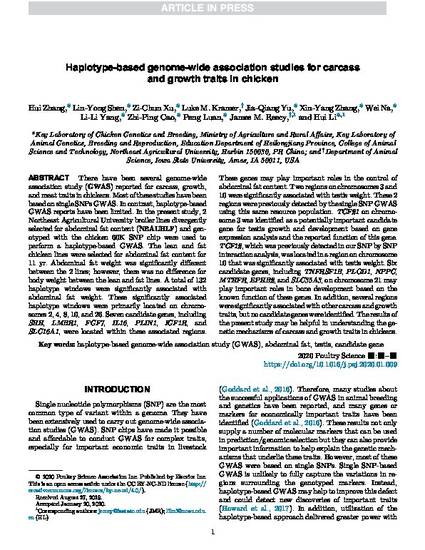
There have been several genome-wide association study (GWAS) reported for carcass, growth, and meat traits in chickens. Most of these studies have been based on single SNPs GWAS. In contrast, haplotype-based GWAS reports have been limited. In the present study, 2 Northeast Agricultural University broiler lines divergently selected for abdominal fat content (NEAUHLF) and genotyped with the chicken 60K SNP chip were used to perform a haplotype-based GWAS. The lean and fat chicken lines were selected for abdominal fat content for 11 yr. Abdominal fat weight was significantly different between the 2 lines; however, there was no difference for body weight between the lean and fat lines. A total of 132 haplotype windows were significantly associated with abdominal fat weight. These significantly associated haplotype windows were primarily located on chromosomes 2, 4, 8, 10, and 26. Seven candidate genes, including SHH, LMBR1, FGF7, IL16, PLIN1, IGF1R, and SLC16A1, were located within these associated regions. These genes may play important roles in the control of abdominal fat content. Two regions on chromosomes 3 and 10 were significantly associated with testis weight. These 2 regions were previously detected by the single SNP GWAS using this same resource population. TCF21 on chromosome 3 was identified as a potentially important candidate gene for testis growth and development based on gene expression analysis and the reported function of this gene. TCF12, which was previously detected in our SNP by SNP interaction analysis, was located in a region on chromosome 10 that was significantly associated with testis weight. Six candidate genes, including TNFRSF1B, PLOD1, NPPC, MTHFR, EPHB2, and SLC35A3, on chromosome 21 may play important roles in bone development based on the known function of these genes. In addition, several regions were significantly associated with other carcass and growth traits, but no candidate genes were identified. The results of the present study may be helpful in understanding the genetic mechanisms of carcass and growth traits in chickens.
Available at: http://works.bepress.com/james_reecy/147/

This article is published as Zhang, Hui, Lin-Yong Shen, Zi-Chun Xu, Luke M. Kramer, Jia-Qiang Yu, Xin-Yang Zhang, Wei Na et al. "Haplotype-based genome-wide association studies for carcass and growth traits in chicken." Poultry Science 99 (2020): 2349-2361. doi: 10.1016/j.psj.2020.01.009.